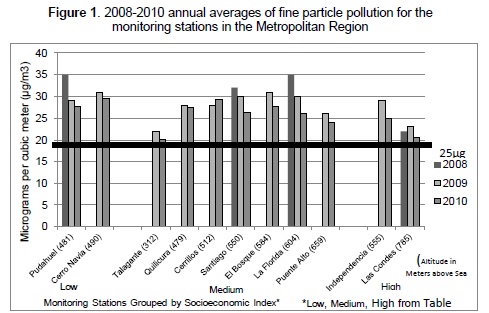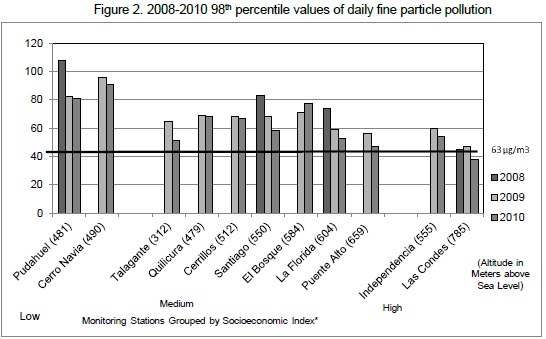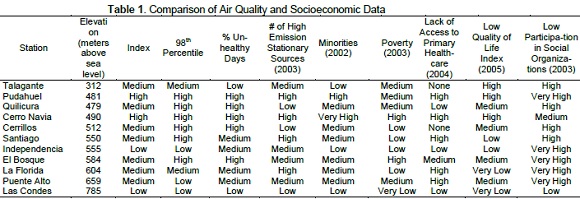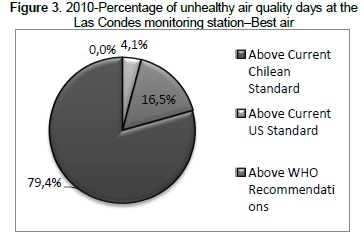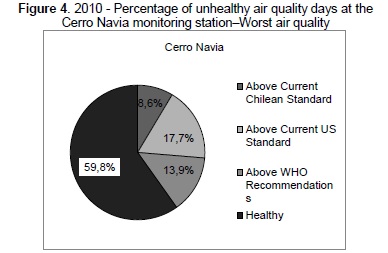Services on Demand
Journal
Article
Indicators
-
 Cited by SciELO
Cited by SciELO -
 Access statistics
Access statistics
Related links
-
 Cited by Google
Cited by Google -
 Similars in
SciELO
Similars in
SciELO -
 Similars in Google
Similars in Google
Share
Revista de Salud Pública
Print version ISSN 0124-0064
Rev. salud pública vol.17 no.3 Bogotá May/June 2015
https://doi.org/10.15446/rsap.v17n3.38465
http://dx.doi.org/10.15446/rsap.v17n3.38465
Artículos/Investigación
Environmental justice and air quality in Santiago de Chile
Justicia medioambiental y calidad de aire en Santiago de Chile
Richelle Rose-Pérez
University of Washington. Daniel J. Evans School of Public Policy and Governance, Seattle, USA. Environmental Planner. chellethezag@gmail.com
Received 15th June 2013/Sent for Modification 23th April 2014/Accepted 12th March 2015
ABSTRACT
Objective The metropolitan region in Santiago, Chile has an air quality problem. However, the larger issue may lie in the inequities created by the distribution of the air pollution.
Methods To assess the inequities created by the spatial differences in air pollution, the author analyzed fine particle pollution levels for 2008-2011 at monitoring stations throughout the region. The author also compared air quality data with socioeconomic data.
Results The areas of the Santiago metropolitan region with the worst air quality have lower socioeconomic levels. Pollution in these areas reaches levels higher than the current Chilean 24 hour standard for fine particles. These areas also have longer time periods of unhealthy air and 21 % more days with unhealthy levels of air pollution.
Discussion The differences in exposure to pollution create an inequality and environmental injustice among the socioeconomic groups in the metropolitan region. Chilean policymakers have the regulatory tools needed to improve environmental justice. However, they need to improve the implementation of these tools in order to achieve that goal: Chilean policy makers should consider local sources of air pollution in the most polluted municipalities; Government decision makers should make extra efforts to listen to the community and improve access to environmental information; Environmental justice advocates should involve stakeholders from the social justice movement and other related areas; Policy makers should track progress towards environmental justice by evaluating differences in health outcomes related to differential exposure to air pollution in different parts of the Santiago metropolitan area.
Key Words: Environment and public health, air quality, air pollution, Latin America, South America, Chile (source: MeSH, NLM).
RESUMEN
Objetivo La región metropolitana en Santiago de Chile tiene un problema con la calidad del aire, en medio de inequidades creadas por la distribución de la contaminación del aire.
Métodos Evaluar las inequidades creadas por las diferencias espaciales en los niveles de contaminación en la región metropolitana y comparar los datos de la calidad del aire con datos socioeconómicos.
Resultados Las áreas de la región metropolitana de Santiago con la peor calidad del aire tienen los niveles socioeconómicos más bajos. La contaminación en estas áreas llega a niveles mayores que la norma Chilena para material particulado fino en 24 horas. También tienen periodos con aire contaminado más largos y tienen 21 % más días con niveles de contaminación que afectan la salud humana.
Discusión Las diferencias en la exposición a la contaminación crean inequidad e injusticia medioambiental entre los grupos socioeconómicos en la región metropolitana. Las autoridades responsables tienen herramientas regulatorias cuya implementación debe mejorarse para lograr la justicia medioambiental: Las autoridades responsables deben examinar las fuentes locales en las municipalidades más contaminadas; El gobierno debe tomar medidas extras para escuchar a la comunidad y mejorar el acceso a la información medioambiental; Los defensores de la justicia medioambiental deben involucrar grupos ciudadanos; Las autoridades responsables deben marcar el progreso a la justicia medioambiental con una evaluación de las diferencias de salud relacionadas con las diferencias de exposición a la contaminación del aire.
Palabras Clave: Medio ambiente y salud pública, calidad de aire, contaminación del aire, América Latina, América del Sur, Chile (fuente: DeCS, BIREME).
A large influence on Santiago's pollution is the combination of its geography and weather patterns. The area forms the shape of a large bowl because it is completely surrounded by mountains. The air pollution reaches its peak during a weather condition known as an inversion. During an inversion, warm air higher in the atmosphere, traps a layer of cold air near the surface. Without wind to push the air out and an inversion preventing the pollution from moving up, air quality quickly deteriorates to unhealthy levels. Transportation is the largest source of air pollution in the region (1). Industry and residential wood burning are also sources of air pollution in the region.
Breathing particle pollution is linked to negative health effects. Particles can travel deep into our lungs and circulatory system. The smaller the particle, the more harmful they are. They have both short-term and long-term health effects including respiratory disease, decreased heart and lung function, asthma attacks, heart attacks, strokes and premature death. Particle pollution affects everyone but has the most harmful effects on children, older adults, and people with respiratory and heart disease (2). Several health studies in the Santiago metropolitan region connected high levels of air pollution with increased mortality and adverse health effects on the elderly and the young (3-6).
What has Santiago Metropolitan Region Done to Improve Air Quality?
The Santiago Metropolitan started making significant efforts to reduce air pollution in the area in the 1990s. Most controls have focused on reducing industrial and transportation related emissions. The yearly average of fine particle concentrations improved from the upper 70s (in micrograms per cubic meter) to somewhere near 301. Although the region has had success with its reduction effort, they still have more work to do to clean up the air. Many parts of Santiago metropolitan region still have long-term levels of fine particle pollution that are unhealthy. The region struggles with short periods, ranging from one to several days, with very high levels of pollution during winter.
Where is Air Quality the Worst?
Concerns of inequality stem from a concern about which areas of the Santiago metropolitan region experience the worst air quality. There are two major weather patterns that create the conditions needed for poor air quality episodes. The first weather scenario creates the worst air quality for the western parts of the metropolitan area such as Pudahuel. The second weather scenario results in the worst air quality in the southern end of the metropolitan area including El Bosque and Cerrillos (7).
Lower socioeconomic groups in the Santiago metropolitan region are exposed to elevated levels of coarse particles. Additionally, there is inequality in the distribution of environmental benefits and hazards in the Santiago metropolitan region and throughout Chile (8). Major inequality stems from who creates and experiences the highest levels of pollution. The communities of the region with the highest socioeconomic status create the most pollution but live in areas with the least environmental degradation from that pollution.
Environmental Justice in Latin America and Chile
Environmental justice provides a framework for improving and mitigating the inequalities associated with the distribution of air pollution in the region. The simplest definition of environmental justice is equal access to a healthy living environment where we live, work, and play. It involves the equal distribution of both environmental benefits and environmental burdens or hazards. Environmental justice involves finding ways to reduce the unequal distribution of environmental risks and environmental benefits among socioeconomic classes and race (9).
The development of Latin American cities has allowed them to segregate on the basis of class. Higher socioeconomic groups leave the center of the city and seek out locations with the best environment - both natural (more green spaces and less pollution) and infrastructure (easy highway access to downtown) (10). Environmental injustices in Latin America are not usually the result of the purposeful siting of environmental hazards next to poor neighborhoods (11). Instead it is the result of a slow process where higher socioeconomic groups have the ability to pay for the best environmental conditions (12).
In addition to the same influences seen throughout Latin America, environment injustice persists in Chile because tools are not used effectively (13). Information is not presented in a way that is easy for the lay person to understand and communities lack the opportunity to participate in decisions that affect their quality of life (14).
METHODS
In order to assess the extent of environmental injustice related to fine particle pollution in Santiago metropolitan region, the author compared air quality and socioeconomic data across the region.
Air Quality Data
Using Microsoft Excel, the author analyzed fine particle (PM2.5) data for the Santiago Metropolitan Area from 2008 through 2010 (http://www.seremisaludrm.cl/sitio/pag/aire/indexjs3aireindices-prueba.asp). The analysis included data from all 11 monitoring stations in the metropolitan region. The author analyzed the 98th percentile of daily concentrations to evaluate the potential for short term health effects. Daily concentrations represent the average of hourly concentrations measured from midnight for each day of available data. For the stations that had three years of data, the author calculated the average of 3 years of annual averages and three years of 98th percentile values. This helps show the air quality trend and reduces the effect of meteorology in the calculation. The author also examined an annual average of pollution concentrations to evaluate the potential for long term health effects.
Percentage of Unhealthy Air Quality Days
For each monitoring station, the author calculated the percentage of days in each of the following categories:
- Days above the current Chilean 24 hour fine particle standard of 63 micrograms per cubic meter (µg/m³)
- Days above the current United States 24 hour fine particle standard of 35 µg/m³
- Days above the future Chilean 24 hour fine particle standard (in 2032) and the World Health Organization's recommendation for a 24 hour fine particle standard of 25 µg/m³
- Healthy days that monitored a 24 hour fine particle level at or below 25 µg/m³
Socioeconomic Data
The author analyzed socioeconomic data from the "Socioeconomic Atlas 2006" prepared by the Metropolitan Regional government (http://otas.gorerm.cl/Gore/Docs/DOC_ATLAS_02.pdf). The atlas compiles socioeconomic data from a variety of years and presents the data by municipality on maps of the Metropolitan Region. The author examined the following categories of data:
- Number of high emission stationary sources (2003)
- Percentage minority population (2002)
- Poverty level (2003)
- Lack of access to primary healthcare(2004)
- Quality of Life Index (2005)
- Participation in Social Organizations (2003)
To compare the socioeconomic data with my analysis of the air quality data, the author developed a matrix that categorized the air quality and socioeconomic data into "Very Low," "Low," "Medium," "High," and "Very High." The categories are assigned by the potential for environmental injustice so that they are comparable across types of data. For example, low for air quality relates to a low level of pollution while low for participation in social organizations relates to a municipality with a socially active population.
RESULTS
Air Quality
Only two stations in the metropolitan region had annual averages that fell below the current Chilean fine particle standard of 25 µg/m³. All of the annual averages fell between 20 µg/m³ and 35 µg/m³. Therefore, the majority of residents in the metropolitan area are exposed to fine particle pollution at levels that cause long term health concerns. Figure 1 shows the annual average for all 11 monitoring stations in the metropolitan. The line shows the current Chilean annual standard for fine particles.
The 98th percentile values show larger variance across the metropolitan region. Most of the monitoring stations have 98th percentile values at or close to the Chilean 24 hour standard of 63 µg/m³.
Residents in Santiago, Pudahuel, and Cerro Navia experienced high levels of short term fine particle pollution from 2008-2010. In 2009 and 2010 Cerro Navia has the highest 98th percentile values. Cerro Navia did not have fine particle data for 2008. The highest 98th percentile value in the data set occurred at Pudahuel in 2008. Figure 2 shows the 98th percentile values for all 11 monitoring stations in the metropolitan region. The line indicates the current Chilean 24 hour standard for fine particle pollution.
Comparison of Air Quality and Socioeconomic Data
Las Condes has the best air quality in the Metropolitan Region. It also has a low number of high emission stationary sources, low percentage of minorities, very low level of poverty, adequate access to primary healthcare, a high quality of life index, and high level of participation in social organizations. On the other hand, Pudahuel and Cerro Navia have the worst air quality in the Metropolitan Region. They also have a high number of high emission stationary sources, larger number of minorities, more poverty, and a lack of access to primary healthcare. Pudahuel has very low participation in social organizations. Cerro Navia on the other hand has a medium level of participation in social organizations.
Table 1 shows the results of this comparison. It lists the monitoring station from lowest elevation to highest and shows an index of the air quality and socioeconomic indicators as low, medium, and high.
Municipalities with the Best Air Quality
The effects on health also depend on how often levels of pollution are high. In 2010, all monitoring stations showed healthy levels of air quality between 54 % and 80 % of days. Las Condes had the healthiest days at 79.4 % of days. Pudahuel and Cerro Navia, the areas with the worst air quality had only healthy days about 60 % of the time. It also had no days above the current Chilean 24 hour standard. Talagante has a pie chart that looks similar to the Las Condes monitoring station.
Municipalities with the worst air quality
In terms of percentage of unhealthy air quality days in 2010, the Cerro Navia monitoring station showed the worst air quality in the metropolitan region.
It had 8.6 % of days above the current 24 hour Chilean standard, an additional 17.7 % days above the current U.S. standard, and an additional 13.9 % days above the WHO recommendations.
DISCUSSION
In the Santiago metropolitan region, municipalities with the worst pollution have lower socioeconomic levels than the municipalities with better air. One would expect to see more cases of respiratory illness, asthma, and other health effects associated with high levels of fine particle pollution in the municipalities with the worst pollution. Additionally Santiaguinos of higher socioeconomic levels contribute a disproportionately high amount of the pollution because they live farther from the urban center and depend more on cars. The poorer Santiaguinos depend on public transportation to a greater degree (15).
Not only is there an inequality of exposure to air pollution, these communities are already dealing with lower levels of health. Throughout the western world, socioeconomic status is associated with health. Higher socioeconomic status results in better health outcomes while lower socioeconomic status is associated with worse health outcomes (16). This gap exists in Chile despite the existence of a two-tiered health system with a public component, known as FONASA, and private component, known as ISAPRE.
Studies have also documented a connection between socioeconomic status, high exposure to air pollution, and poor health outcomes (17-19). A recent study from the U.S. EPA documented more emergency department visits from people of lower socioeconomic status during high levels of exposure to fine particle pollution during wildfires in North Carolina (20). The levels of fine particle pollution seen during the wildfires were of similar levels seen in Santiago metropolitan region during bad air quality days.
Poor respiratory health is a complex health problem with several potential causes in addition to poor air quality. For example, quality of housing is poorer at lower socioeconomic levels, which is a potential trigger for respiratory illness. The combination of lower health status and higher exposures to air pollution may make poorer communities more susceptible to the ill effects of air pollution. This creates a potential disproportionate health effect. This disparity between socioeconomic classes is an environmental injustice. Chilean policy makers should take this injustice into consideration when deciding appropriate air pollution reduction strategies in the region.
Consider Local Pollution Controls
Air pollution controls in the Santiago metropolitan region have focused on regional reductions from transportation and industrial sources. While these have reduced air pollution across the region, many municipalities in the region need additional reductions to improve air quality. Many air quality policy makers blame the higher concentrations on meteorology and topography. Local air pollution may also contribute to the higher concentrations. In order to get air quality in all areas of the region to healthy levels, policy makers may need to consider local pollution control measures in the areas with the highest concentrations. This requires additional information about the mix of local sources.
One way to identify the mixture of pollution sources in an area is through speciated monitoring data. Speciated monitoring data separates and measures the various chemical components in the fine particle pollution. It provides a chemical fingerprint of the fine particle pollution in the air. One can then match the fingerprint with a pollution source such as cars, industry, or wood stoves. The Chilean Environmental Ministry should consider adding speciated monitors to their monitoring sites with the highest levels of pollution.
Listen to the Community
Another way to identify the mixture of pollution sources in an area is to ask the community. Policy makers need to connect the community with the experts. The people living in a community know a lot about what goes on in their neighborhoods on a daily basis. They can provide information that no one else can if policy makers are open to listening.
Because of their national focus, the Chilean Ministry of Environment may find it hard to connect to the community at a grass-roots level. So, they should seek out existing relationships at other levels of government. For example, the municipal governments know their communities and have established relationships which involve a higher level of community participation than currently exists at the federal level. Another group to consider working through is the Consejo Económico y Social Comunal. This is an advisory group made up of community representatives. This group exists in every municipality in Chile and they are often well established in the municipalities with lower socioeconomic status (22).
Early involvement: The Chilean public information requirements come at the end of the process. The policymakers will need to make an extra effort to involve the communities early when policies and ideas are still easily changed.
Explain the Science: Policymakers often assume that the community does not have the ability to participate in creating the solution to the problem because policymakers feel that the communities do not understand the scientific side of the problem. Policymakers should make a concerted effort to explain the scientific side of the problem and their research findings to the community in a way they understand. The Chilean Ministry of the Environment should consider an annual or biannual report on their progress towards healthy air in the Santiago metropolitan region. The Chilean government has not published a report of this sort since 2003.
Listen: The final element of meaningful public involvement is to give the stage to the community and listen. The community often can provide resources important to successful implementation. An involved community may have more buy-in to the solutions. Their involvement also reduces government distrust. An involved community can also work to demand the attention of politicians or other policymakers that have not yet brought their attention to the environmental injustice.
Involvement of Additional Stakeholders
Policymakers should also work with the community to identify areas for additional research and potential solutions to the problem. The environmental justice movement in Chile could benefit from coalitions with the following groups:
Social justice advocates: One of the key factors to the success of the environmental justice movement in the United States lay in its ability to connect it to the social justice movement. Chile has a very strong social movement focused on anti-poverty and discrimination based on class. Additionally, the human rights movement in Latin America is very strong because of the history of human rights violations during military dictatorships.
Women's groups: Children makeup one of the most susceptible groups to air pollution. A movement focused on improving environmental justice related to air quality in the Santiago metropolitan region could use this to its benefit to involve women's groups in their coalitions. Movements focused on the benefits to family life are often more successful in gaining political ground in Chile.
Sustainability: Chile and the Santiago metropolitan region in particular, has a growing number of nongovernmental organizations focused on environmental sustainability and creating a healthy living environment. The mission of organizations such as Ciudad Viva would fit nicely into a coalition focused on environmental justice.
Track Progress
In the metropolitan area, one could track changes in health outcomes related to air quality in the municipalities with higher exposures to air pollution as a potential measure of improvements in environmental justice to show improvements and progress. Ideally, the measure should index pollution levels, indicators of socioeconomic status, and, if possible, health outcomes. Public health literature has identified the need for further study of the connections between socioeconomic status, air pollution, and health outcomes. The Santiago metropolitan area presents a "natural experiment" to explore this connection and improve the quality of life of the citizens breathing the air in municipalities such as Pudahuel and Cerro Navia.
Pie de página
1 Zuñiga A, Mauricio G. [Estudio Integrado de Factores que Influyen Sobre la Contaminación Atmosférica por Material Particulado Respirable de Pudahuel]. Tesis de grado de Maestría en Gestión y Planificación Ambiental [2010] Se localiza en: Universidad de Chile, Santiago.
REFERENCES
1. Bell ML, Davis DL, Gouveia N, Borja-Aburto VH, Cifuentes LA. The avoidable health effects of air pollution in three Latin American cities: Santiago, Sao Paulo, and Mexico City. Environmental Research. 2006; 100:431-440. [ Links ]
2. Cakmak S, Dales RE, Blanco Vidal C. Air Pollution and Mortality in Chile: Susceptibility among the Elderly. Environmental Health Perspectives. 2007; 115 (4): 524-527. [ Links ]
3. Cifuentes LA, Vega J, Kopfer K, Lave LB. Effect of the Fine Fraction of Particulate Matter versus the Coarse Mass and Other Pollutants on Daily Mortality in Santiago, Chile. Journal of the Air & Waste Management Association. 2000; 50 (8):1287-1298. [ Links ]
4. Grass D, Cane, M. The effects of weather and air pollution on cardiovascular and respiratory mortality in Santiago, Chile, during the winters of 1988-1996. International Journal of Climatology. 2008; 28: 1113-1126. [ Links ]
5. Ilbaca M, Olaeta I, Campos E, Villaire J, Tellez-Rojo MM, Romieu I. Association Between Levels of Fine Particulate and Emergency Visits for Pneumonia and other Respiratory Illnesses among Children in Santiago, Chile. Journal of the Air & Waste Management Association. 1999; 49 (9): 154-163. [ Links ]
6. Ostro BD, Eskeland GS, Sanchez JM, Feyzioglu T. Air Pollution and Health Effects: A Study of Medical Visits among Children in Santiago, Chile. Environmental Health Perspectives. 1999; 107 (1): 69-73. [ Links ]
7. Gobierno de Chile CONAMA Metropolitana de Santiago. Evolución de la Calidad del Aire en Santiago 1997-2003. Santiago, Chile: Andros Impresores; 2003. [ Links ]
8. Vasquez A, Salgado M. Desigualdades socioeconómicas y distribución inequitativa de los riesgos ambientales en las comunas de Peñalolén y San Pedro de la Paz. Una perspectiva de justicia ambiental. Revista de Geografía Norte Grande. 2009; 43:95-110. [ Links ]
9. Bryant B. [Editorial]. Environmental Justice. Issues, Policies, and Solutions. Washington, D.C: Island Press; 1995. [ Links ]
10. Arriagada Luco C, Rodriguez Vinoli J. Segregación residencial en áreas metropolitanas de América Latina: magnitud, características, evolución, e implicaciones de política. Naciones Unidas; 2003. [ Links ]
11. Carruthers DV. [Editorial]. Environmental Justice in Latin America. Problems, Promise, and Practices. Cambridge, MA: The MIT Press; 2008. [ Links ]
12. Leichenko RM, Solecki WD. Consumption, Inequity, and Environmental Justices: The Making of New Metropolitans Landscapes in Developing Countries. Society & Natural Resources: An International Journal. 2008; 21(7): 611-624. [ Links ]
13. Centro de Derechos Humanos. Informe Anual sobre Derechos Humanos en Chile. 2007. [Internet]. Disponible en: http://www.derechoshumanos.udp.cl/archivo/informe-anual/. Consultado agosto de 2012. [ Links ]
14. Instituto Nacional de Derechos Humanos. Resumen Ejecutivo Informe Anual 2011. [Internet]. Disponible en: http://www.indh.cl/wp-content/uploads/2012/03/resumen-ejecutivo-2011.pdf. Consultado Octubre 2012. [ Links ]
15. Laurent O, Bard D, Filleul L, Segal C. Effect of socioeconomic status on the relationship between atmospheric pollution and mortality. Journal of Epidemiology and Community Health. 2007; 61: 665-675. [ Links ]
16. Grineski SE, Staniswalis JG, Peng Y, Atkinson-Palombo C. Children's asthma hospitalizations and relative risk due to nitrogen dioxide (NO2): Effect modification by race, ethnicity, and insurance status. Environmental Research. 2010; 110: 178-188. [ Links ]
17. Bell ML, O'Neill MS, Cifuentes LA, Braga ALF, Green C, Nweke A, Rogat J, Sibold, K. Challenges and recommendations for the study of socioeconomic factors and air pollution health effects. Environmental Science & Policy. 2005; 8: 525-533. [ Links ]
18. Samet JM, White RH. Urban air pollution, health, and equity. Journal of Epidemiology and Community Health. 2004; 58. 3-5. [ Links ]
19. Martins MCH, Fatigati FL, Vespoli TC, Martins, LC, Pereira LAA, Martins MA, Saldiva PHN. Influence of socioeconomic conditions on air pollution adverse health effects in elderly people: an analysis of six regions in Sao Paulo, Brazil. Journal of Epidemiology and Community Health. 2004; 5: 41-46. [ Links ]
20. Rappold AG, Cascio WE, Kilaru VJ, Stone SL, Neas LM, Devlin RB, Diaz-Sanchez D. Cardio-respiratory outcomes associated with exposure to wildfire smoke are modified by measures of community health. Environmental Health. 2012; 11:71. [ Links ]
21. Mena-Carrasco M, Oliva E, Saide P, Spak SN, de la Maza C, Osses M. Tolvett S, Campbell E, Tsao TC. Molin LT. Estimating the health benefits from natural gas use in transport and heating in Santiago, Chile. Science of the Total Environment.2012; 429: 257-265. [ Links ]
22. Subsecretaria de Desarrollo Regional y Administrativo. Participación Ciudadanía en la gestión de gobiernos regionales y municipios: Diagnostico situación actual; 2004. [ Links ]













